You can also listen to this article in the voice of own Plastic Artist Rosângela Vig:

Little Nose didn't like to wait; She was annoyed to have to wait for Pete for a whole week. But fortunately it was jaboticaba time. There were several jaboticaba trees in Mrs. Benta's small farm, but one was enough to make them all sick to nausea. Just that week the jaboticabas had come to the spoon point, and the girl did nothing but suck on the delicious fruits. (…) She chose the prettiest ones, put them between her teeth and tloc! And after the tloc, a little broth and – pluf! – lump out. And tloc, pluf, tloc, pluf and spent all day in the tree. (LOBATO, 2019, p.11)
Step by step 18 – Color and shape perception
It is very likely that Little Nose, Pete and Mrs.Benta are among the sweetest memories of Brazilian childhood. The smart girl, the adventurous cousin and the loving grandmother are some of Monteiro Lobato's characters who populated the stories we read the most and the ones we imagined to live. Brazilian childhood still holds memories that awaken the palate, such as the delights prepared by Mrs. Benta, Auntie Anastácia and those delights that nature itself manufactures, such as Brazilian fruits, including jaboticabas. In the passage above, Little Nose is delighted with these little treats of the small farm. To those who know it is possible that the mouth salivates when seeing the black ball, very glossy; at the sound of its clicking, when the shell breaks, letting the mouth taste the precious and thick, white, sweet content. There is no similar taste.
The small ball, covered in luminous black casing, is striking, catches the eye in the foreground and induces the taste. Its inexplicable sweetness is unlike any other fruit, and its flavor is even better when it is picked straight from the tree, often in the backyard of grandma's house, of an aunt, between friends, sharing and searching among them, the largest and the candiest. There could be no better memory of the best period of life, with the kids gathered or with the family. The jaboticaba is among the portraits of Brazil.
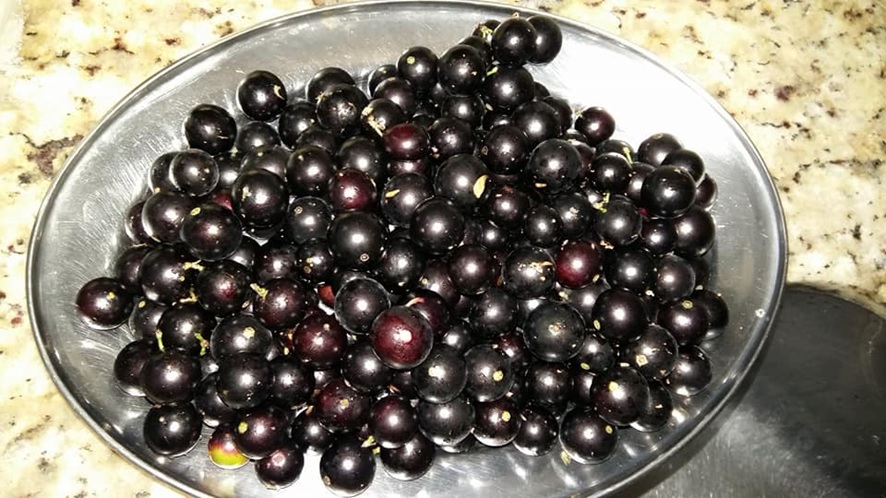
The sleek peel of the little fruit mirrors the light, the sky, and the delighted gaze of its appreciator. Its very black color looks like an eye looking at us with the delicious childhood innocence. Accompanying early Spring in Brazil, September brings with it the endless burst of fruit on the trees and that's when the jaboticaba trees trunks are covered in black.
Snacking on this tasty fruit is perhaps as delicious as reproducing it Art. Watching it with an artist's eye induces the mind to wander through childhood and the longing old days, as if the glossy black cup that hugs the fruit still mirrors those times and so many other times, like marbles. Over the black wrap it is possible to unveil many colors; You can see the reflected sky, the trunks of the leafy tree and its green leaves. Like glass marbles, the jaboticabas of figure 1 reflect what surrounds them, the colors, the images. At the top of each fruit the white color shows the incidence of light and the gray color comes next, at points where illumination is not direct; Then black comes where the light doesn't shine. Some fruits still show earthy, brown, red and even purple tones. But it is still noticeable a splash of blue over all the fruits, which, in a way emphasizes the white of the light that shines.
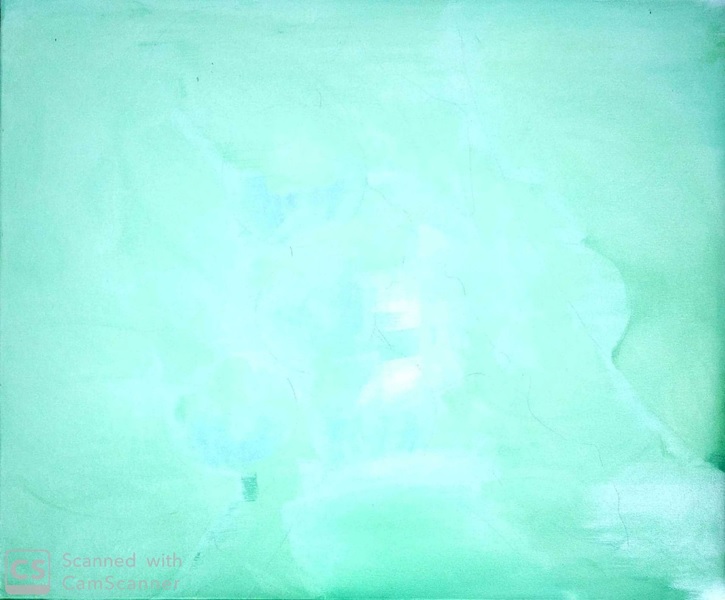
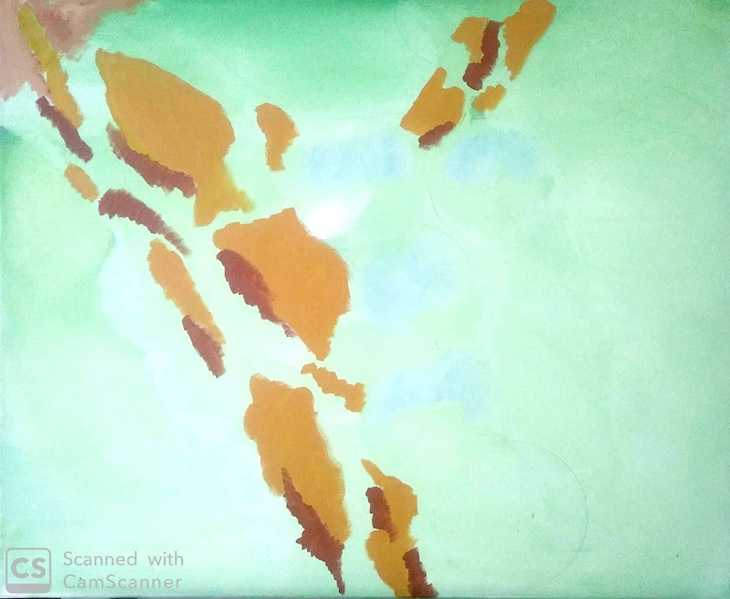
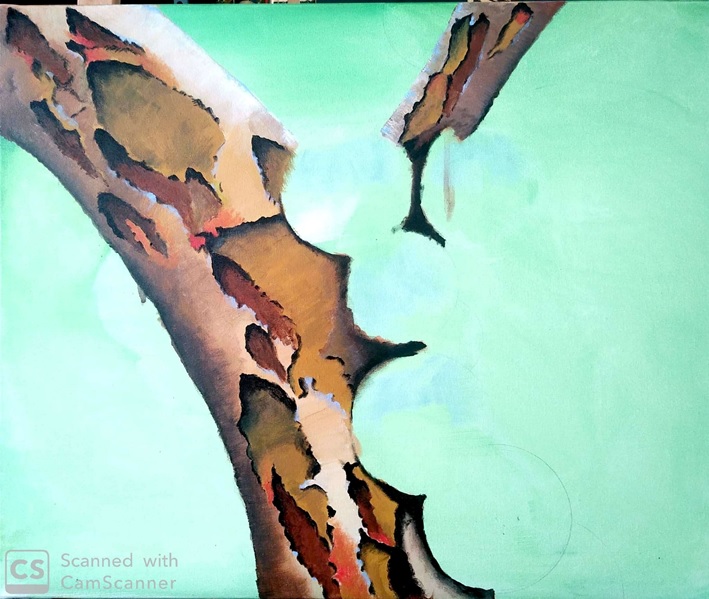
Observing the nuances of the fruit, to Art can then emerge free on the white canvas. With the watery acrylic paint (Fig. 2) you can paint the green background of the vegetation around the protagonists of the scene, which will be the trunk and the fruits. Amidst the green, the first strokes of the trunk stand out (Fig. 3) with shades of brown and ocher. ote that the tree is not one color only, because it peels as it grows, leaving the new bark that replaces the old one at the bottom. In this way, the earth tones are different, lighter or darker as the shell is more hidden or more exposed. In addition, the lichen or fungus that cover the trunk surface can also change the colors of the tree, staining it with reddish tones as seen in figure 4. But this lichen may still have other colors, depending on the environment where the tree is. Still in figure 4 the shadows are accentuated with black under the peelings that are coming off the trunk. In this case, black does not dissipate too much, it remains only where there is no light, so don’t lrt the Black stand out the other colors, so that the depth does not become excessive. The blue finishes the trunk, in some places making the where the light is more evident.
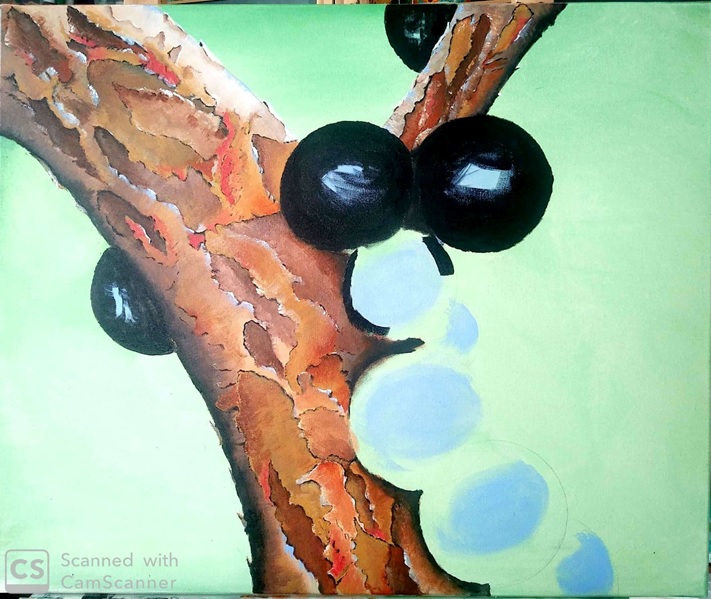
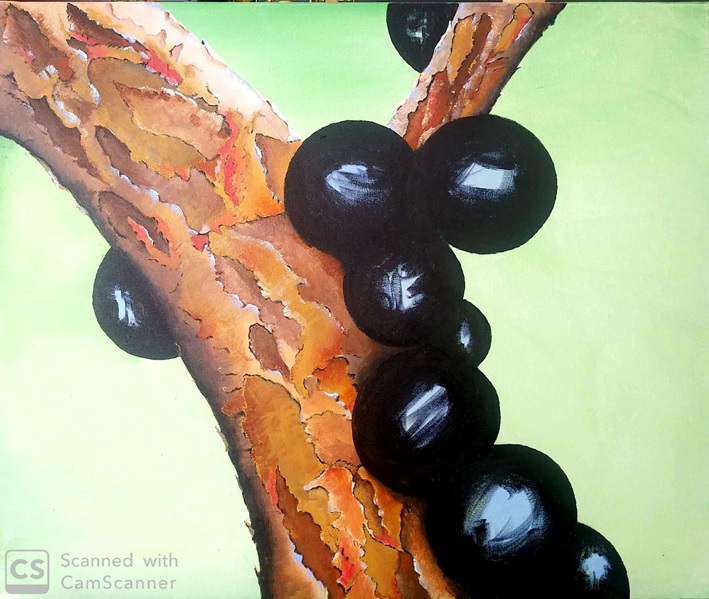
With the bottom and trunk ready, you can now start the jaboticabas, the most delicious part of the painting. Like any drawing or painting, light should always come from the same direction. In this case, the light comes from the upper front of the scene. Then the fruits should have a light dot on their front, as in figure 5, where this point is white. The berries are gray where light falls indirectly and black where there is no light.
Blue and purple overlapped a little over gray as can be seen in figure 7. This in a way highlights the clarity on the fruits and the partially reflected images, like a mirror. After the color transition has been completed, it is now possible to finish, with the cables and a slight splash of green (Fig. 9), since, near the cables or when the fruits are ripening, some jaboticabas can have this color. Now it is the time to reinforce the fruit shadows on each other and on the trunk, with the black, very light, being careful not to darken the scene too much. The white paint here also reinforces the dark, because it happens where there is light, as opposed to black. Blue splatters the scene again and enhances white. The scene is now ready. Note that there are not many elements, just the fruits in their nuances and the trunk, on a simple green background.
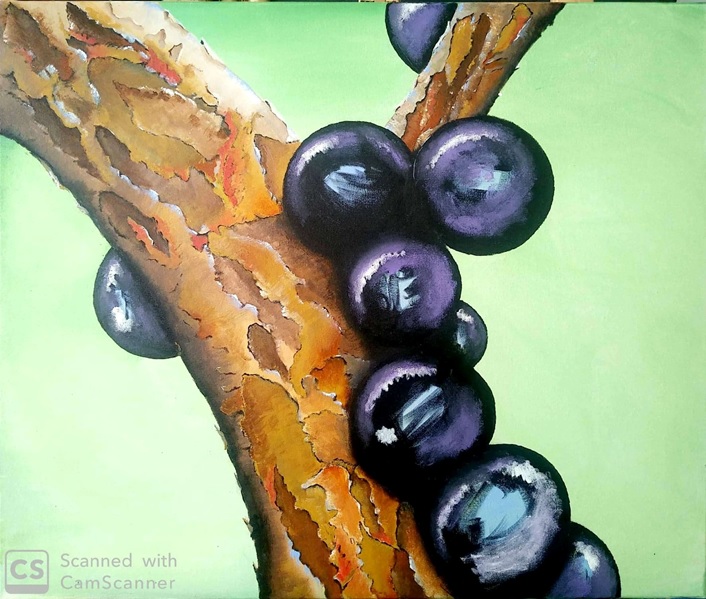
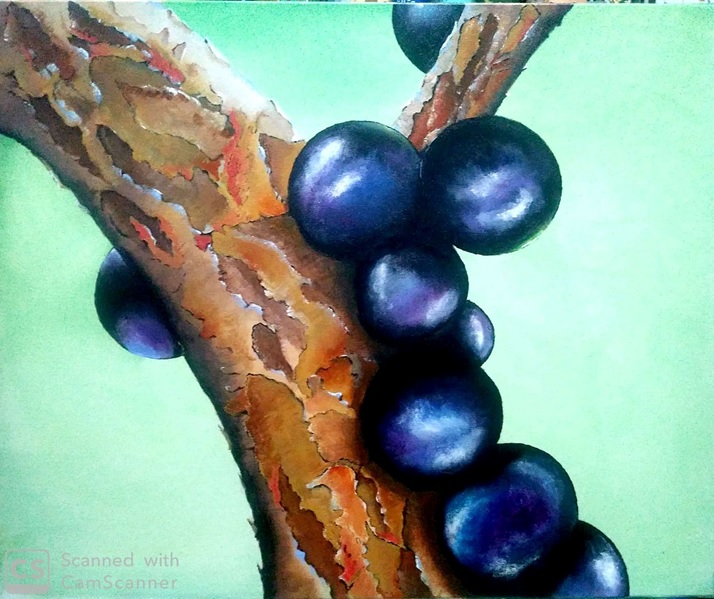
In some cases, both Painting and Drawing, too much detail is unnecessary, because it exhausts the vision and pollutes the image. In this case the fruits and the trunk are the main characters and there would be no need for any other element. The intention was to cause the observer to want to pull the fruit from the trunk, and to eat it. And maybe savoring the fruit straight out of the tree is the biggest trip we can make to the best times of our lives.
September is cerertainly the most beautiful month in Brazil. That is when the eye can be delighted by the flower beds and gardens of this immense country dotted with colors; and it is also this time that the taste can still be satisfied with the fruits of our land.
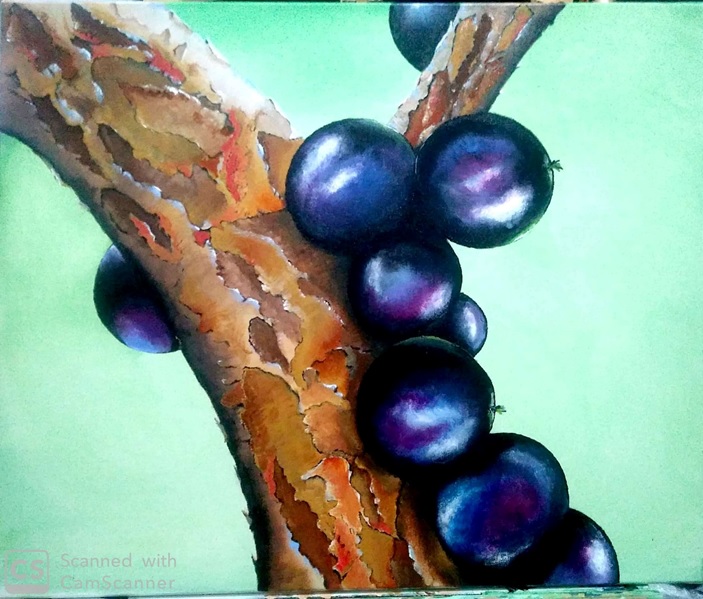
I am the earth, I am the life.
From my clay came first the man.
From me came the woman and came the love.
The tree came, the wellspring came.
The fruit comes and the flower comes.
I am the original source of all life.
I am the floor that attaches to your house.
I am the roof tile of your home.
(CORALINA, 2004, 311)
…
Liked? [highlight]Leave a comment[/highlight]!
You might also like:
- Design – Artistic Production, Step by step 17 of how to draw by Rosângela Vig
- Drawing – Painting on Canvas, Step by step 16 of how to draw by Rosângela Vig
- Design – Study of the Form, Step by step 15 of how to draw by Rosângela Vig
- Design – Artistic Production, Step by step 14 of how to draw by Rosângela Vig
- Design – Artistic Production, Step by step 13 of how to draw by Rosângela Vig
- Design – Artistic Production, Step by step 12 of how to draw by Rosângela Vig
- Design – Artistic Production, Step by step 11 of how to draw by Rosângela Vig
- Design – Artistic Production, Step by step 10 of how to draw by Rosângela Vig
- Design – Artistic Production, Step by step 9 of how to draw by Rosângela Vig
- Design – Artistic Production, Step by step 8 of how to draw by Rosângela Vig
- Design – Artistic Production, Step by step 7 of how to draw by Rosângela Vig
- Design – Artistic Production, Step by step 6 of how to draw by Rosângela Vig
- Drawing and Painting – The Abstract, Step by step 5 of how to draw by Rosângela Vig
- Drawing – Movement, Step by step 4 of how to draw by Rosângela Vig
- Drawing – Study of Colors, Step by step 3 of how to draw by Rosângela Vig
- Drawing – Study of Light and Shadow, Step by step 2 of how to draw by Rosângela Vig
- Drawing – Study of Perspective, Step by step 1 of how to draw by Rosângela Vig
Articles about the Art History of Rosângela Vig:
References:
- CORALINA, Cora.Melhores Poemas. São Paulo: Global Editora, 2004.
- LOBATO, Monteiro.Turma da Mônica – O Sítio do Picapau Amarelo. Barueri, SP: Ed. Sunflower, 2019. Adaptation: Regina Zilberman.
The figures:
Fig. 1 –Jaboticabas, 2017, Andrea Ramos Molina.
Fig. 2 –Jaboticabas, Wallpaper, 2019, Rosângela Vig.
Sign up to receive Event News
and the Universe of Arts first!
Fig. 3 –Trunk of jaboticabeira, 2019, Rosângela Vig.
Fig. 4 –Jaboticabeira trunk with lichen and shadows, 2019, Rosângela Vig.
Fig. 5 –Trunk with jaboticabas, 2019, Rosângela Vig.
Fig. 6 –Jaboticabas still unfinished in the trunk, 2019, Rosângela Vig.
Fig. 7 –Jaboticabas still unfinished in the trunk, 2019, Rosângela Vig.
Fig. 8 –Jaboticabas on the trunk, 2019, Rosângela Vig.
Fig. 9 – Jaboticabas on the trunk, 2019, Rosângela Vig.
ROSÂNGELA VIG
Sorocaba – São Paulo
Facebook Profile | Facebook Fan Page
Website Columnist at Website Obras de Arte
E-mail: rosangelavig@hotmail.com

